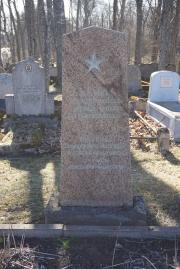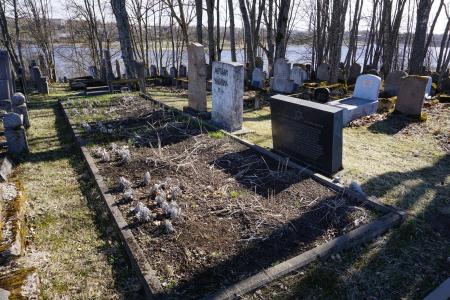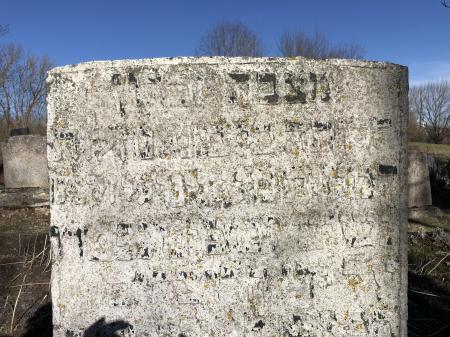Obj. ID: 44093
Jewish Funerary Art Old Monument on the Mass Grave in the New Jewish Cemetery in Ludza, Latvia, 1950s(?)
To the main object: New Jewish cemetery in Ludza, Latvia

Memorial Name
No official name
Who is Commemorated?
Victims of the Ludza Ghetto, reinterred in the cemetery after WWII.
Description:
This is a mass grave of Jewish victims from the Ludza Ghetto reinterred here after WWII.
Three stelas are situated on the grave.
The oldest one, in the middle, was made of stone in the 1950s. On its side looking toward the grave, there is a Russian inscription “To the victims of Fascism, 1941,” while a long Hebrew inscription appears on the other side.
The second stele, on the right, was made of red granite in 1961, see:
The third stele, on the left, was erected in the 1990s, see:
Inscriptions
Russian:
Жертвам
фашизма
1941 г.
Translation: To the victims of Fascism, 1941
Hebrew:
מצבת זכרון
חרותה בלבינו נוזלות
דמעות מעינינו על זקנינו
נשינו וטפינו נפטרו
על ידי הרוצחים
הפאשיסטן שנשרפו
[ר]בנינו דקהילתינו
וינקום נקמת דם
עבדיך השפוך
Translation: Monument of memory, inscribed in our hearts, tears are running from our eyes about our old people, our women and our children, killed by the Fascist murderers, our rabbis of our community. [He] will revenge the spilled blood of Your servants [Ps. 79:10].
Commissioned by
Surviving Jews of Ludza
sub-set tree:
The Nazi German troops entered Ludza on 3 July 1941. On the following day, arrests of Jewish refugees and “Soviet activists” began. 25 people from among the arrestees were shot on the outskirts of the town, in the vicinity of a brick factory, on July 15, 1941. A ghetto was established in Ludza in mid-July 1941. 35 old Jews, including rabbi Benzion Don-Ihie, were shot at the end of July 1941 at the intersection of Rēzekne St. with Parka St, Liepājas St. and Rupniecibas St. After the war they were reinterred in the Jewish cemetery. 10 more Jews were shot at “Lauderi” farm at the end of July 1941. They were also reinterred in the Jewish cemetery.
A mass murder of Jews from the Ludza ghetto took place in mid–August 1941, when about 600 people were taken to the Cirma Lake (about 7 km from Ludza) and shot. 40 more Jews were shot there on August 27, 1941. In October 1941 part of the remaining ghetto inmates were sent to Daugavpils, some were shot near Dzerkaļi village, and others were shot near Kotāni village on November 13, 1941. The last inmates of the ghetto were murdered in Garbari Forest on April 3, 1942.
The reburial of the victims took place in the Jewish cemetery after WWII. Rabbi Benzion Don-Ihie was reinterred in a separate grave (see here).
The first monument with Hebrew and Russian inscriptions was probably erected in the 1950s. Its Hebrew epitaph is similar to the epitaph on the monument near the cemetery in Rēzekne (see here).
The second monument was probably erected in 1961. It is identical to the monument in Zilupre (see here) and very similar to the monument in the Garbari Forest near Ludza (see here).
The third monument was erected by the relatives of several families in the 1990s.
In the 1970s, commemorative events in Ludza were reported in the Soviet Latvian press (Zeltser, 199).
"Holocaust Memorial Places in Latvia," a website by the Center for Judaic Studies at the University of Latvia, http://memorialplaces.lu.lv/memorial-places/latgale/ludza-municipality-the-ludza-jewish-cemetery/.
Meler, Meyer, Jewish Latvia: Sites to Remember (Tel-Aviv: Association of Latvian and Estonian Jews in Israel, 2013), p. 239.
Meler, Meyer, Mesta nashei pamiati: Evreiskie obshchiny Latvii, unichtozhennye v Kholokoste (Riga: by the author, 2010), p. 270.
Rochko, Josif, Jewish Latgale: Guidebook (Daugavpils, by the author, 2018), p. 36.
Zeltser, Arkadi, Unwelcome Memory: Holocaust Monuments in the Soviet Union, trans. A.S. Brown (Jerusalem: Yad Vashem, 2018), p. 199.













